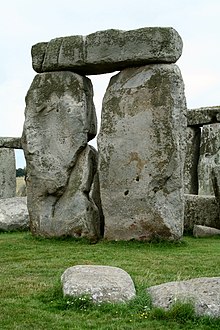Trilith

A trilith ( ancient Greek τρεῖς, τρία treis, tria , German 'three' and λίθος lithos 'stone, rock') is a gate , passage or an architectural element that consists of two bearing stones and a (third) capstone on top, an independent statics and is not directly interlocked with other components.
Triliths ( English trilithon ) were mainly used in Neolithic or Bronze Age buildings in megalithic construction, including in Stonehenge or in the temples on Malta ( Ħaġar Qim , Kordin , Mnajdra , Tarxien on the Ġgantija ). The use of three-point unprocessed stones, as they are, for. B. occur in the yoke structures of passage graves or large dolms, however, does not meet the criterion, because only gate-like three-stone construction methods are so designated, even if they had no gate function, as in the Sarsen circle of Stonehenge.
Baalbek

Deviating from normal usage, a group of three giant building blocks lying next to one another in the Roman temple complexes of Baalbek in Lebanon, known for their gigantism, is also called a trilith. Their average weight is 800 t, which means that the ensemble is not only one of the largest ancient monoliths , but also one of the whole of history .
Individual evidence
- ↑ Adam 1977, p. 52
literature
- Jean-Pierre Adam: Speaking of you trilithon de Baalbek. Le transport et la mise en oeuvre des mégalithes. In: Syria. Vol. 54, No. 1/2, 1977, ISSN 0768-2506 , pp. 31-63, online .
- Joachim von Freeden: Malta and the architecture of its megalithic temples . Scientific Book Society, Darmstadt 1993, ISBN 3-534-11012-9